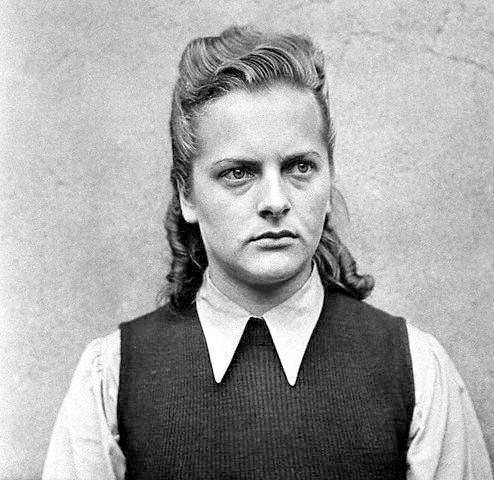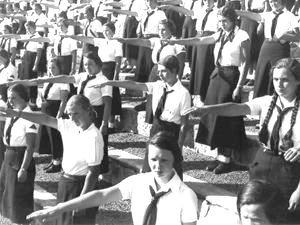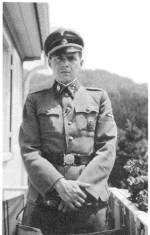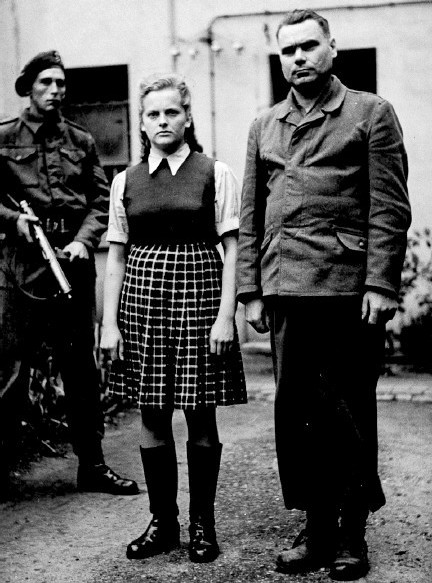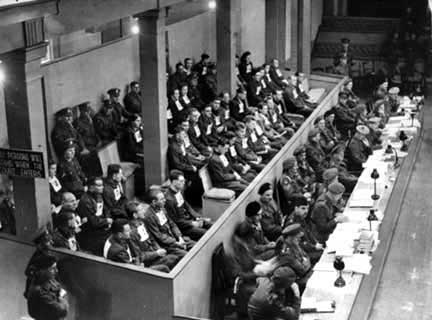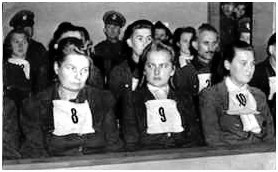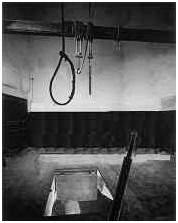Holocaust Education & Archive Research Team |
|
Trials Introduction to the Holocaust Trials
Trials
Interrogations & Testimonies
The IMT Series Nazi Justice
| |||||
Irma Grese Excerpts from the Belsen Trial and Biography
Irma Grese was born on the 7 October 1923 and in 1938 she left elementary school and worked for six months on agricultural jobs at a farm, after which she worked in a shop in Lychen for six months.
When she was fifteen she went to a hospital in Hohenlychen where she stayed for two years, she tried to become a nurse but the Labour Exchange would not allow that and sent her to work in a dairy in Furstenburg.
In July 1942 she tried again to become a nurse, but the Labour Exchange sent her to Ravensbruck Concentration Camp, although she protested against it, she stayed there until March 1943, when she was transferred to the Auschwitz-Birkenau camp.
She remained in Auschwitz until January 1945.
After Auschwitz Irma Grese was sent to the Bergen – Belsen Concentration Camp where she was captured by the British Army when they liberated the camp on 15 April 945. She became known as the “Bitch of Belsen” as the details of her crime became known.
Helene Grese testified:
“I am the sister of Irma Grese, 20 years old and live at Wrecken in Wreckensburg. My father was an agricultural worker, and I have two sisters and two brothers, my mother died in 1936. When she was 14 years old, my sister Irma worked on a farm of a peasant in a village near where we lived.
From the time she entered the Concentration Camp Service I saw her twice. In 1943 she came home on leave, and the only thing she told us about her work was that her duties consisted of supervising prisoners so that they would not escape.
I saw her when she left Auschwitz in 1945, and she told me that she had been working for a considerable period in a sort of a post office, receiving and distributing mail, and that some times she had been detailed to guard duties.
From your knowledge of your sister, do you think her a person likely to beat the prisoners under her charge?
No.
In our schooldays when, as it sometimes happens, girls were quarrelling and fighting, my sister never had the courage to fight , but on the contrary she ran away.
When your sister went to work on the farm when she was 14, how long did she stay there?
About six months to a year.
Where did she go from there?
She went to Hohenlychen, as a sort of a nurse, and then to a small dairy in Furstenburg, where she worked, I believe twelve to eighteen months.
Did she go from there into the SS?
Yes in 1942 she went to Ravensbruck, which was very near us.
How long before 1943 was it since you had seen your sister?
In spring 1942 when she was working in the dairy.
When she came home in 1943, did your father give her a thrashing?
I did not see that, but he was quarrelling with her because she was in the SS.
Did he forbid her to come to the house again?
I do not know. She never came again.
Was not that because she told you what she did at Ravensbruck?
I do not know why.
You would be 16 at that time, you never asked what she was doing in the concentration camp, and she never told you?
She told us she was supervising the prisoners working inside the compound, and she had to see that they were doing their work well and that they did not escape.
We asked her, “What do the prisoners get for food, and why have they been sent to a concentration camp?” and she answered that she was not allowed to talk to the prisoners and did not know what sort of food they got.
Why did your father lose his temper with her?
Because he was very much against her being in the SS. We all wanted to belong to the Bund Deutscher Madchen but he never allowed us to do so. I have not seen my father since April 1945.
Irma Grese questioned by her lawyer Major Cranfield.
Did you carry a stick at Auschwitz?
Yes an ordinary walking stick
Did you carry a whip at Auschwitz?
Yes, made out of cellophane in the weaving factory in the camp. It was a very light whip, but if I hit somebody with it, it would hurt. After eight days Kommandant Kramer prohibited whips, but we nevertheless went on using them, I never carried a rubber truncheon.
Where did the order come from for what we call “selection parades”?
That came by telephone from a Rapport-Fuhrerin or from Oberaufseherin Dreschel.
When the order came were you told what the parade was for?
No
What were the prisoners supposed to do when the whistle went?
Fall in fives, and it was my duty to see that they did so. Dr Mengele then came and made the selection. As I was responsible for the camp, my duties were to know how many people were leaving and I had to count them, and I kept the figures in a strength book.
After the selection took place they were sent into “B” Camp, and Dreschel telephoned and told me that they had gone to another camp in Germany for working purposes or for special treatment, which I thought was the gas chamber.
I then put in my strength book either so many for transfer to Germany to another camp, or so many for S.B. (Sonderbehandlung). It was well known to the whole camp that S.B. meant the gas chamber.
Were you told anything about the gas chamber by your senior officers?
No the prisoners told me about it.
You have been accused of choosing prisoners on these parades and sending them to the gas chamber. Have you done that?
No: I knew that prisoners were gassed.
Was it not quite simple to know whether or not the selection was for the gas chamber, because only Jews had to attend such selections?
I myself had only Jews in Camp C.
Then they would all have to attend the selection for the gas chamber, would they not?
Yes
As you were told to wait for the doctors you would know perfectly well what it was for?
No
When these people were parading they were often paraded naked and inspected like cattle to see whether they were fit to work or fit to die, were they not?
Not like cattle.
You were there keeping order, were you not, and if one ran away you brought her back and gave her a beating?
Yes
Examination by her defence counsel
The witness Szafran has accused you of beating a girl at Belsen with a riding crop about a fortnight before the British troops arrived, and also that at Auschwitz during a selection two girls jumped out of a window and you shot them while they were lying on the ground. Is that true?
I never shot at all at any prisoner.
Earlier the Prosecution had examined D. Szafran:
Whilst you were at Auschwitz did you see any other persons beaten besides yourself?
I saw it very often when I was working in Kommando 103 and we were carrying loads of earth and coal. I have seen Kramer beat a person so often that I cannot really say how many times. I have seen Grese do it in Auschwitz and about a fortnight before the British troops liberated Belsen I saw her beat a girl in the camp.
She had a pistol, but she was using a riding crop. The beatings were very severe. If they were not the cause of death, they were not called severe in the camp.
Grese’s counsel had cross-examined D. Szafran:
Do you remember telling us that you had seen Grese No 9, beating a girl in Belsen about a fortnight before the British troops arrived?
I remember it now, it was in the kitchen. Grese was not the kitchen Kommandant, she came in there with the Lager Kommandant on inspection.
She beat the girl with a riding whip made of leather.
If I tell you that at Auschwitz Grese carried a stick and sometimes a whip, but at Belsen she never carried either, are you sure that you are not confused over this incident?
In Auschwitz she wore a pistol and in Belsen she went about with a riding whip. She was one of the few SS women who had a permit to carry arms. I cannot say whether she was wearing a pistol at the time of this incident.
Perhaps it is possible that by that time members were not allowed to carry arms.
Then upon re-examination of this witness by the Prosecution
You said that you could tell us of a good many more instances of Grese’s conduct?
Yes. In Camp A, Block 9, Blockalteste Ria and Hoessler and Dr Enna, the prison doctor made a selection for the gas chamber, and two selected girls jumped out of the window and Grese approached them as they were lying on the ground and shot them twice.
She was always active in the camp gate making inspections and if any of the prisoners wore another sock or shoe or anything like that, he or she would be beaten up.
I cannot remember with what she used to beat them because I had to stand at attention.
You have been asked a good many questions about dates. Were you given calendars either at Auschwitz or Belsen?
No but I remember very well because they were so terrible and ghastly.
Irma Grese’s examination by her own counsel
The witness Stein told us that at selection in the summer of 1944 some prisoners tried to hide, but that you saw them, told somebody and a woman was shot. It was suggested that the woman was shot by an SS man or guard. Had you any authority to issue orders to an SS guard?
No
The same witness alleged there was an incident when a mother was talking to her daughter over the wire between two compounds, that you arrived on a bicycle and beat the mother so severely that she was lying on the ground where you kicked her?
I do not deny that I beat her, but I did not beat her until she fell to the ground, and I did not kick her either.
Ilona Stein’s earlier cross-examination by Grese’s counsel
With regard to the incident you described of a woman being shot when trying to escape from a selection parade in Auschwitz, was she Hungarian?
Yes
You described an incident when Grese arrived on a bicycle and beat another woman, did she beat her with her belt?
I do not know exactly what was in her hands, but I did see that she had something in them. I do remember, however, that I have seen Grese taking off her belt and beating prisoners with it.
Was the body taken away on a stretcher by hand or was it taken away by something on wheels?
When somebody died, which happened in very many cases, he was simply put into a blanket and dragged away.
Have you ever beaten by Grese yourself?
No not in the kitchen where I was working.
But once when I was out on a working party, Grese saw me talking to somebody through the barbed wire and she immediately started beating me.
Did you see Grese beating a great many people a great many times at both camps?
I saw her more frequently doing this in Auschwitz than in Belsen
Was the reason you only had this one beating from her because you behaved yourself well?
I had not very great contact with her because working in the kitchen we were rather separated.
Ilona Stein deposition reads in part
Whilst I was at Birkenau an SS woman named Irma Grese was responsible for many beatings, one murder and sending people to the gas chamber. I identify No 2 on photograph Z/4/2 as Irma Grese.
What I speak of I speak of to my own knowledge.
In July 1944 I was working in the kitchen at Birkenau when I saw a woman, whose daughter was in an adjoining camp, go to the dividing wire in order to speak to her daughter. Grese who was passing on a bicycle, immediately got off, took off her leather belt and beat the woman with it.
She also beat her on the face and head with her fists, and when the woman fell to the ground she trampled on her. The woman’s face became swollen and blue. A friend of the woman’s daughter took her away and the woman was in the hospital for three weeks suffering from the effects of the beating.
I saw everything myself that Grese did to this victim.
Whilst at Birkenau I have seen Grese making selections with Dr Mengele of people to be sent to the gas chamber. On these parades Grese herself chose the people to be killed in this way.
In one selection about August 1944, there were between 2,000 and 3,000 selected. At this selection Grese and Mengele were responsible for selecting those for the gas chamber.
People chosen would sometimes sneak away from the line and hide themselves under their beds. Grese would go and find them, beat them until they collapsed and then drag them back into line again.
I have seen everything I describe. It was general knowledge in this camp that persons selected in this way went to the gas chamber.
Sometime in August or September 1944, at one of these selection parades, one Hungarian woman who had been selected tried to escape from the line and join her daughter in another line which was for those not chosen.
Grese noticed this and ordered one of the SS guards to shoot the woman, which he did. I did not hear the order, but saw Grese speak to the guard and she was shot at once. In the company of some nurses from the hospital I took the dead body to the mortuary.
Irma Grese under Prosecution questioning by Colonel Backhouse:
You affected heavy top-boots and you liked to walk around with a revolver strapped on your waist and a whip in your hand, did you not?
I did not like it.
You thought it very clever to have a whip made in the factory and even when the Commandant told you to stop using it you went on, did you not?
Yes
What was this whip really made of?
Cellophane paper plaited like a pigtail. It was translucent like white glass
The type of whip you would use for a horse?
Yes.
Then most of these prisoners who said they saw you carrying a riding whip were not far wrong, were they?
No, they were not wrong.
Did the other Aufseherinnen have these whips made too?
No
It was just your bright idea?
Yes
In Lager “C” you used to carry a walking stick too, and sometimes you beat people with the whip and sometimes with the stick?
Yes . Were you allowed to beat people?
No
So it was not a question of having orders from your Superiors to do it. You did this against orders, did you?
Yes
Were you the only person who beat prisoners against regulations?
I do not know.
Did you ever see anyone else beat prisoners?
Yes
Did you sometimes get orders to do so?
No
Did you give orders to other Aufseherinnen working under you to beat prisoners?
Yes
Had you the right to give such authorisation?
No
Irma Grese left Auschwitz in January 1945 and returned to Ravensbruck Concentration Camp, before being transferred to the Concentration Camp of Bergen –Belsen in March 1945.
Bergen –Belsen was liberated by British troops on the 15 April 1945, amidst indescribable scenes of horror. The Commandant Josef Kramer along with forty-four others including Irma Grese were indicted before a British Military Court under Royal Warrant dated 14 June 1945.
The trial was held between the 17 September 1945 until the 17 November of the same year, Grese was convicted and sentenced to be hanged, along with two other female guards Elizabeth Voilkenrath and Joanna Bormann.
She was executed on the morning of the 13 December 1945 in Hamelin prison.
Sources:
The Complete Transcripts of the Belsen Trial - Wiener Library US National Archives Hitler’s Death Camps by Konnilyn Feig, published by Holmes and Meyer New York 1981 The Holocaust Historical Society archives
Copyright. Victor Smart 2008
|
